12 Must-Try Coleslaw Variations From Around The World
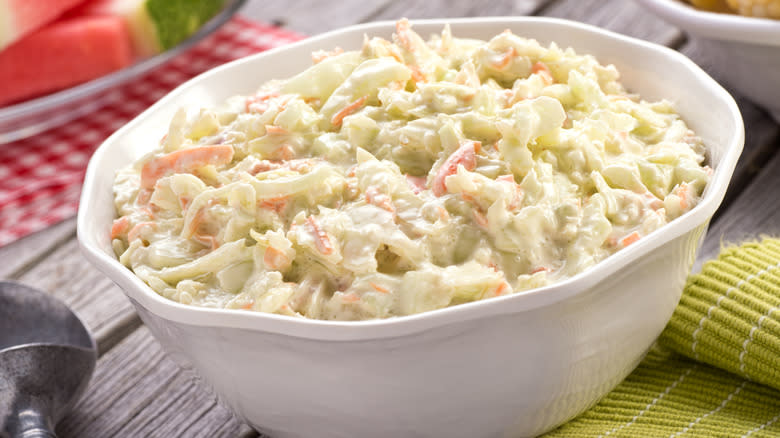
Coleslaw is the perfect addition to any cookout or picnic, the ideal all-American salad ... right? Actually, a look at the history of coleslaw shows that the dish has European roots, an origin evoked in its very name. Koolsla is Dutch for cabbage salad, and it is indeed the Dutch we have to thank for the dish now known as modern coleslaw, with the first known American recipe appearing in 1770 in "The Sensible Cook: Dutch Foodways in the Old and New World."
Admittedly, this recipe didn't look much like the mayo-based salad we now think of as coleslaw. It was dressed simply with oil, vinegar, and melted butter, which we can only assume lent it some of the richness we now get from creamy mayonnaise. However, exploring the original does broaden the scope of what one considers coleslaw significantly. Indeed, there are quite a few cabbage-based salads around the world that could be seen as iterations of coleslaw, from the Ancient Roman marriage of shredded cabbage, vinegar, eggs, and spices to the Pennsylvania Dutch pepper slaw which combines cabbage with bell peppers and is seasoned with mustard and celery seed.
Some slaws purporting to be of international inspiration are in reality American inventions, so we've set to dive into traditional cabbage salads that are genuinely from all over the world. Here are a dozen to savor.
Read more: Mistakes You're Making With Your Corn On The Cob
Dutch Koolsla
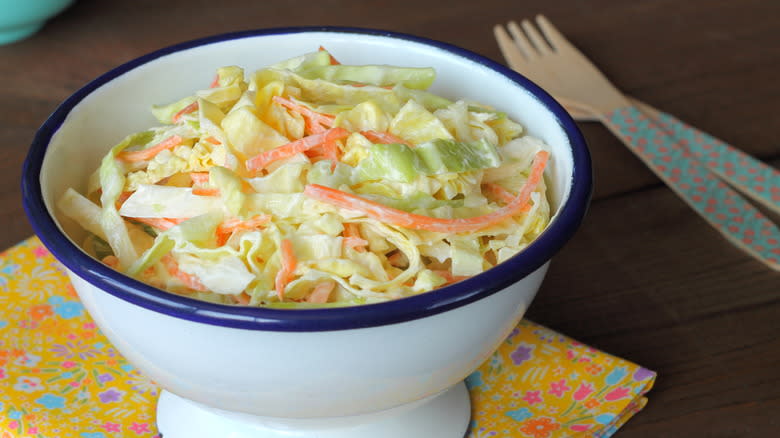
Given the Dutch contribution to the cuisine of what was known as New Amsterdam in the 17th century (it later became New York in 1664), it seems apt to begin our exploration of coleslaw in Holland. However, koolsla, at least as it was described in 1770's "The Sensible Cook," isn't that easy to come by. Most modern Dutch recipe writers associate this ostensibly Dutch salad with the U.S., using the term kool slaai to evoke something closer to a KFC copycat slaw recipe.
Dig a little deeper, however, and truly Dutch creations do surface, though they look different from the original salad and are often simply dressed with a vinaigrette and melted butter. Winterse kool or winter cabbage salad often marries fresh cabbage with apples, bacon, and raisins, all dressed in a creamy, mayo-based dressing. It's not exactly like the cabbage salad that influenced the American version, but with its combo of sweet, savory, and smoky flavors, it's surely delicious.
Mexican Insalada De Col
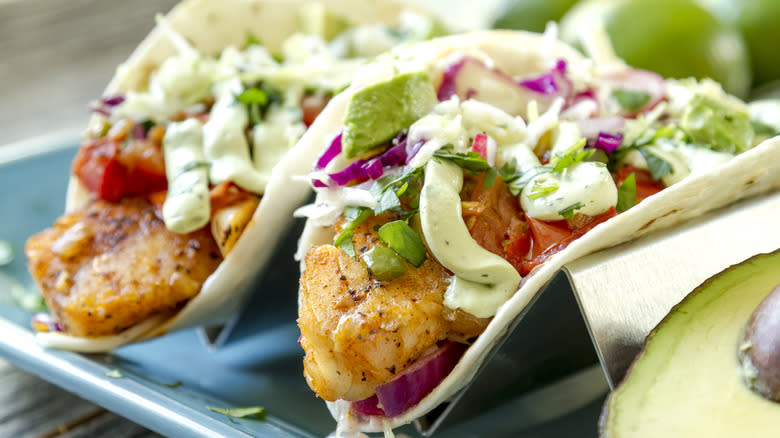
If you've ever eaten a Baja-style fish taco, chances are you've tasted the Mexican answer to cabbage slaw. Traditionally, such slaws are seasoned with just a squeeze of lime; indeed, at its most authentic, this sort of shredded cabbage accompaniment is more of a garnish than a true salad, and it's certainly not present in every region of Mexico.
That said, some Mexican-inspired cabbage salads do more closely resemble coleslaw. Ensalada de col can be made with green and red cabbage or a combination of the two. It's often seasoned with mayo, a pinch of chile, and dried Mexican oregano, which offers a more forward, almost flowery flavor than the grocery store oregano you may be used to. Other variations of this salad may include grated carrot for color and sweetness or call for smoky chipotle chile to lend even more of a kick. A less traditional but equally delicious option would be to showcase the flavors of Mexican street corn in a corn-and-cabbage slaw dressed with spiced mayonnaise, green onions, and feta cheese.
Turkish Lahana Salatası
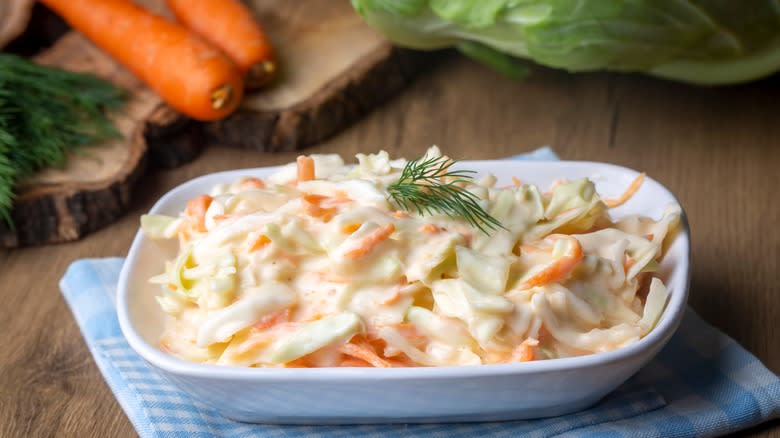
Turkish lahana salatsi can evoke a wide variety of salads, which may be made with all manner of cabbage be it green or red. At its simplest, the cabbage of your choice is tossed with shredded carrot for sweetness and seasoned with salt, lemon juice, and mild vegetable oil. Many cooks suggest that you eschew olive oil, despite it being a local delicacy, for fear it will lend off flavors to the sulfurous brassica.
That said, there are ways to get even more creative with this salad. It can take on some sweetness thanks to apple or onion, and it can also be given a lovely, creamy texture thanks to a dressing made, not with mayonnaise, but rather with yogurt. If you're going to go this route, be sure to seek out full-fat strained or süzme Turkish yogurt. (You can make your own in a pinch by straining Greek yogurt through cheesecloth for eight hours.) Using this thick yogurt will give the salad a creamy rather than watery consistency.
Italian Insalata Irlandese
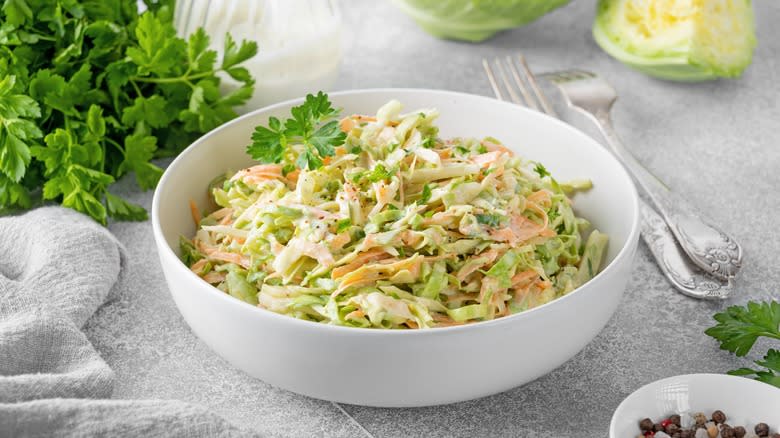
It's often surprising to discover how different countries perceive different dishes, specifically with regard to their origins. Americans insist on giving the French credit for Belgian fries, for example, while the French bafflingly dub a meat-and-fries baguette "American," though it's a sandwich few Americans will have ever encountered.
In Italy, something similar happens with coleslaw, which is sometimes dubbed insalata Irlandese — Irish salad, ostensibly given the association of cabbage with Ireland. This salad is made by combining carrot, spring onion, and cabbage with a sauce made of yogurt, vinegar, mayo, mustard, a touch of sugar, salt, and pepper. The creamy sauce offers a balanced creamy richness with a touch of acidity thanks to the yogurt and vinegar, as well as some sweetness from the sprinkle of sugar. It certainly sounds delicious, if not necessarily uniquely Irish, but we trust the Italians when it comes to the kitchen.
Filipino Atchara
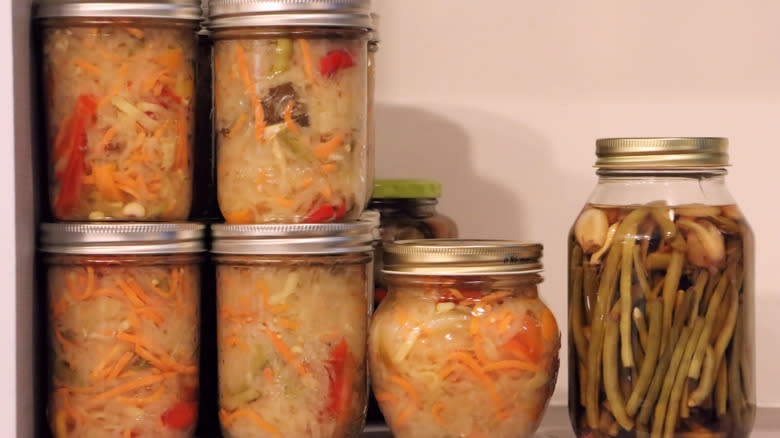
Spicy atchara is much-beloved in the Philippines, a pickled cabbage salad that appears in many forms. The base of most iterations begins not with cabbage but rather with grated green papaya, with its crunchy texture and relatively bland flavor perfect for imparting with all manner of seasonings for the ideal sweet-and-sour condiment to pair with fattier Filipino dishes you may not have tried yet, like fried lumpia or lechón. At its simplest, atchara can be made by quick pickling the papaya with carrots, bell pepper, and loads of garlic. But other recipes, especially in the States where green papaya can be hard to come by, rely instead on cabbage, which is seasoned with spices like coriander.
At Washington, D.C.'s Filipino restaurant Bad Saint, meanwhile, atchara is revisited with more classic American coleslaw recipes in mind. A mix of cabbage, carrot, snow peas, and mung bean sprouts is blanched and cooled before being tossed in a dressing made by puréeing fiery Thai chiles with garlic, ginger, brown sugar, and salt. Lime leaves and shredded coconut add even more flavor to the colorful mélange.
Greek Lahanosalata

In Greece, cabbage salad regularly graces local tables in winter months. A simple combination of white cabbage and carrot is dressed with olive oil, red wine vinegar, salt, and pepper for the ultimate fresh side dish when spring and summer's bounty has yet to arrive. But a base recipe this simple is just begging to be toyed with. Some versions of lahanosalata see the dressing seasoned with mustard or thyme-infused honey for a touch of herbaceousness, while others call for adding a colorful and flavorful blend of red onion, celery, parsley, pomegranate seeds, currants, and walnuts.
Walnuts are indeed a popular addition to Greek iterations of this salad, even simpler ones, and it's not hard to see why. Walnut trees have existed in Greece for thousands of years, long beloved and even revered in the Mediterranean country. They are used frequently in savory dishes like karithosaltsa, a walnut sauce thickened with breadcrumbs and seasoned with garlic and nutmeg. They're also popular in desserts like walnut cake or the Greek version of baklava.
Korean Kimchi Or Namul
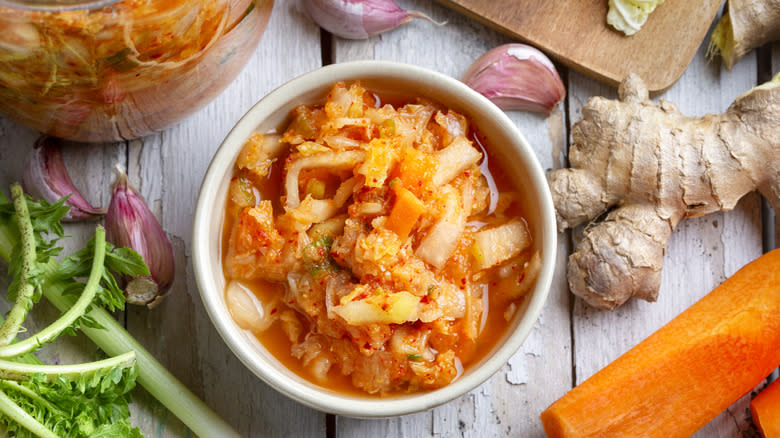
Korean cuisine is rife with cabbage preparations, chief among them being the delicacy that is kimchi. A staple in Korea, kimchi is a spicy, fermented dish that may be made with a range of veggies from radish to cucumber. The most common, however, is made with napa cabbage. While kimchi takes several hours or even days to ferment, depending on the flavor you want, unfermented fresh kimchi is as easy to make as any cabbage slaw. The thinly sliced cabbage is simply seasoned with garlic, scallion, soy, vinegar, honey, sesame oil, lemon juice and spicy chili seasoning. Apricot preserves and fish sauce can be added for even more oomph.
This isn't the only way in which Korea lends its culinary influence to the world of coleslaw. In Korean, namul can refer to any number of vegetable dishes that are seasoned with a base of salt, sesame oil, and soy sauce. A red cabbage and carrot iteration may also include grated garlic and sesame seeds for crunch, while a simple white cabbage version can be seasoned with a touch of umami seasoning for depth.
Japanese Tsukemono
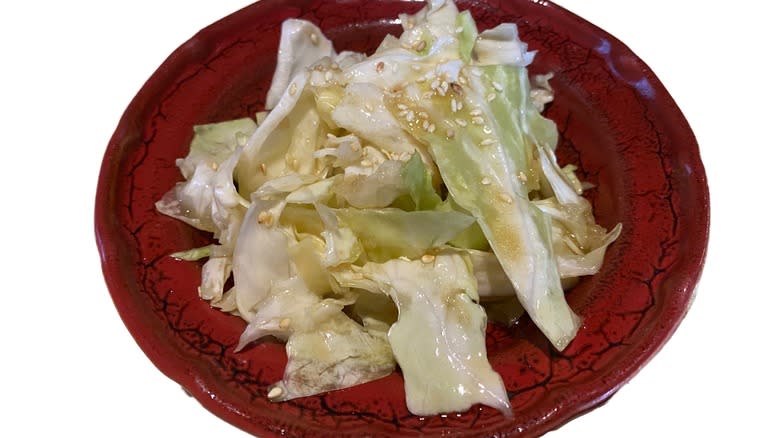
Much like Korean namul, the Japanese word tsukemono can refer to any number of vegetables prepared in the same way, in this case, pickling. These pickles may be made using salt, vinegar, miso, or bran, and they are often fermented until they take on a rich, moreish flavor. A core element of Japanese meals, which often center on a trio of rice, soup, and pickles, tsukemono is meant to cleanse the palate and offer a foil for dishes that are often richly flavored with sweet and umami notes.
The easiest cabbage tsukemono, however, is not fermented but merely quick-pickled in salt that has been seasoned with kombu (a type of dried kelp), which makes it slightly more similar to other coleslaws and cabbage salads around the world. After just a few hours, the cabbage takes on a rich, briny flavor that pairs wonderfully with all manner of Japanese dishes, such as sweet, rich teriyaki salmon. Leafy napa cabbage works great in this salad, thanks to its tender texture.
Lebanese Salatet Malfouf
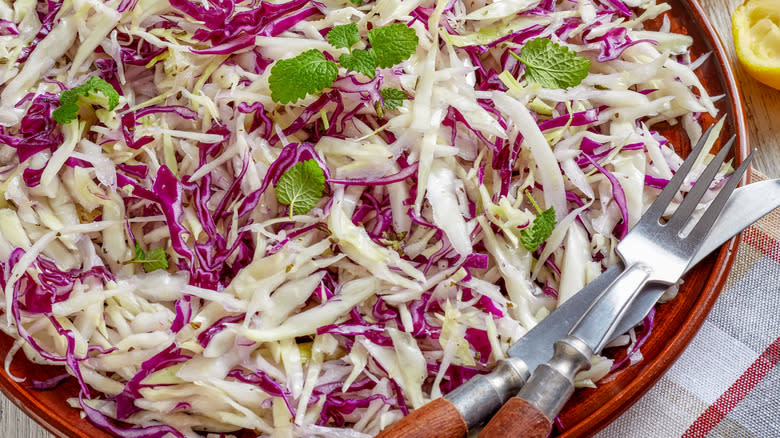
Lebanese cabbage salad might not have the most creative of names (malfouf is Arabic for cabbage), but it more than makes up for it with its bright flavors. Shredded white cabbage, green onion, and parsley are dressed with olive oil, lemon juice, garlic, and mint for a fresh, aromatic slaw. Some recipes even double down on the herbs, dolling up the already fragrant blend with fresh dill and perhaps a few teaspoons of za'atar, a Middle Eastern spice mix that can vary widely from country to country — and even cook to cook. Za'atar often features herbs like oregano or thyme as well as tangy sumac, nutty sesame, and the herb za'atar, also known as hyssop.
Salatet malfouf can certainly stand on its own, but it works particularly wonderfully as a side dish to all manner of Lebanese delicacies from kofta to falafel. Stuff either one into a pita sandwich smeared with Lebanese hummus and garnished with the crunchy, herby salad, and dig in!
Israeli Cabbage Salad
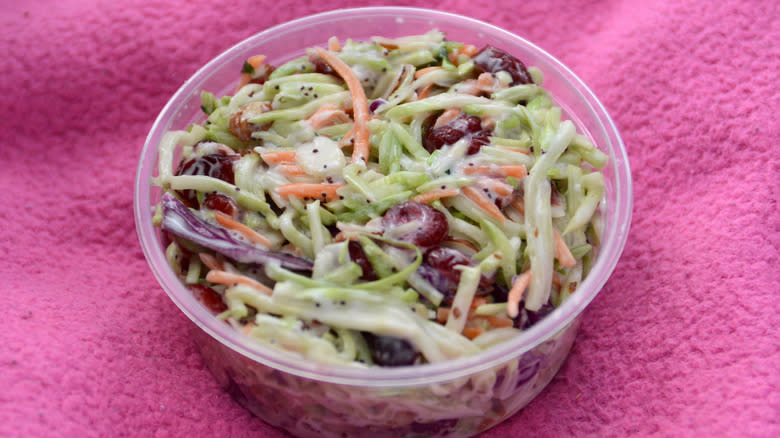
Israeli cuisine boasts a blend of influences from all over the Jewish diaspora. While some typically Israeli dishes, like falafel and hummus, are rooted in the country's geographical location and therefore couldn't feel more Middle Eastern, other culinary hallmarks of Israeli food, like the use of poppy seeds, evoke the traditions of European Ashkenazi Jews. Today, many enjoy the tiny, slightly bitter seeds in everything from triangular hamantaschen pastries to simple noodles with butter.
Poppy seeds also feature in many recipes for Israeli cabbage salad. In addition to poppy seeds, this slaw may be dressed with a creamy tahini sauce or a simpler combo of oil, vinegar, and lemon. Either way, the poppy seeds add a welcome crunch to the dish, which may be served on its own or stuffed into an Israeli falafel sandwich for a true marriage of flavors, textures, and influences that are so representative of Israel.
German Krautsalat

Dishes going by the name krautsalat in Germany may take many forms and can vary widely between households. Some families make a version that is halfway between coleslaw and sauerkraut, boiling the cabbage slightly in salt water to give it a softer texture and extra flavor. This dish is dressed simply with salt, pepper, vinegar, and oil. Other home cooks add a touch of sugar and some sautéed onions for a welcome hint of sweetness to contrast against an acidic vinegar-based dressing. Still others gild the lily, pairing the cabbage with fried smoked bacon and a garnish of parsley for color and brightness.
Warm or cold, sweet or sour, one thing that unites many — but not all — German coleslaw recipes is the frequent use of caraway seeds. This flavorful seed looks a bit like cumin and has a licorice-like aroma and citrus-like brightness. Germany is responsible for quite a much of the world's caraway harvest, along with Poland, Egypt, and Northern India. Caraway seeds can be used in a variety of meals, including rye bread and cooked vegetable dishes. German cooks often feature the spice in breads or salads.
Sichuan Pao Cai
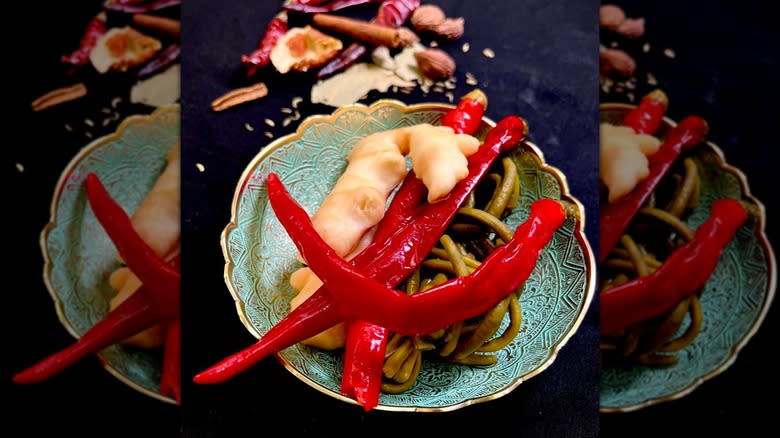
Sichuan cuisine is often known for packing quite a bit of heat, and that certainly holds for pao cai, a cabbage dish that can feature any number of different forms of chile. Some versions of pao cai are quick-pickled, relying on chile oil to lend depth and flavor. Others are fermented, often with dried chiles, Sichuan peppercorns, or a combination of both. Still others add even more flavor to the mix, pairing the hot base with sweet star anise, aromatic bay, cilantro, and garlic for depth.
If you've never tried a Sichuan peppercorn, don't be surprised if it makes your lips and tongue a bit numb. Rather than the fiery heat one associates with other peppercorns or chiles, Sichuan peppercorns give diners a unique electrifying sensation due to hydroxy-alpha sanshool, a mouthful of a molecule with a nigh-electric flavor that creates the numbing, tingling feeling surging across your lips and tongue with every delicious bite.
Read the original article on Mashed.

